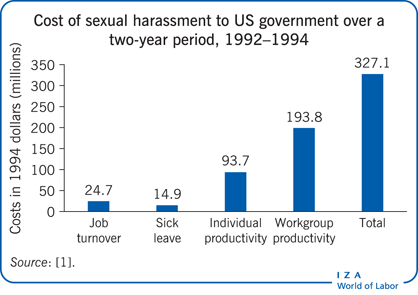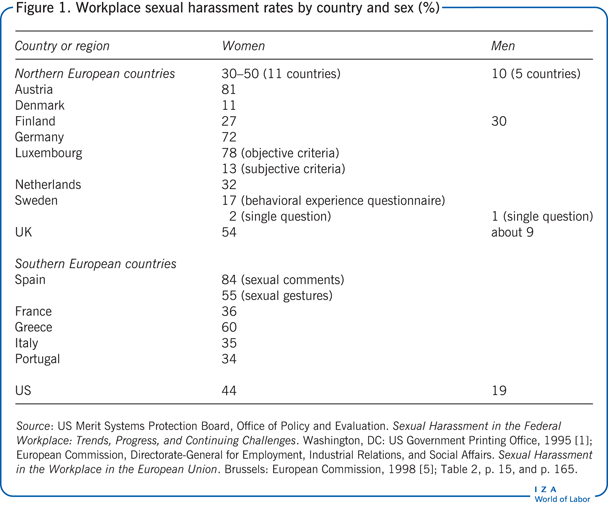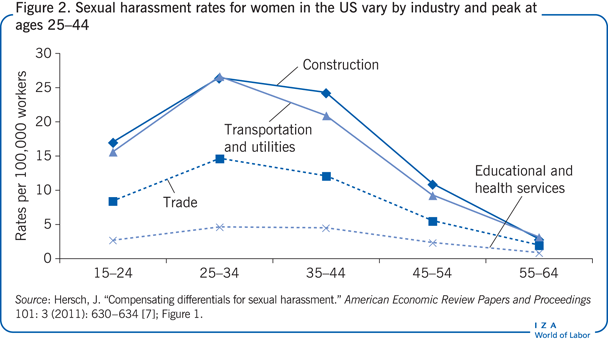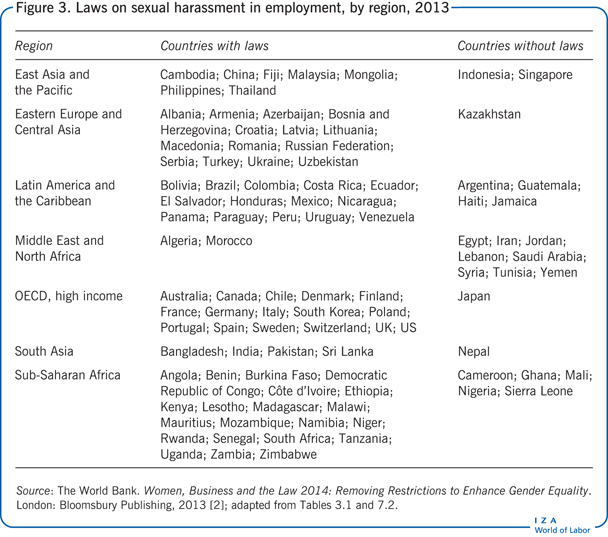Elevator pitch
Workplace sexual harassment is internationally condemned as sex discrimination and a violation of human rights, and more than 75 countries have enacted legislation prohibiting it. Sexual harassment in the workplace increases absenteeism and turnover and lowers workplace productivity and job satisfaction. Yet it remains pervasive and underreported, and neither legislation nor market incentives have been able to eliminate it. Strong workplace policies prohibiting sexual harassment, workplace training, and a complaints process that protects workers from retaliation seem to offer the most promise in reducing sexual harassment.

Key findings
Pros
Largely overlooked until the 1970s, sexual harassment in the workplace is now internationally condemned as a form of sex discrimination and a violation of human rights.
More than 75 countries have legislation prohibiting workplace sexual harassment.
Legislation varies by country and includes protection against workplace sexual harassment under both civil and criminal law.
Like workers at risk of injury or death, those at risk of sexual harassment receive a pay premium.
Organizations have prohibited sexual harassment and have established complaint procedures.
Cons
Sexual harassment is difficult to define, measure, and monitor.
Sexual harassment is underreported, which reduces the efficacy of legislation and workplace policies prohibiting it, as these policies depend on reporting to discourage harassment.
Workers who report sexual harassment are likely to be subject to retaliation.
Women face a higher risk of sexual harassment than men.
Sexual harassment is costly to its victims and to the organizations in which it occurs.
Author's main message
Sexual harassment, a violation of human rights and a form of sex discrimination, is costly to workers and organizations. Yet although more than 75 countries have legislation prohibiting sexual harassment in the workplace, it remains pervasive and underreported. To date, laws and market incentives have been insufficient to eradicate workplace sexual harassment. Success may require policies to enhance market and legal incentives by raising the costs to organizations of tolerating an adverse work environment, promulgating strong policies against sexual harassment, and establishing a complaints process that protects workers from retaliation.
Motivation
Before the 1970s, the term “sexual harassment” would have been met with a blank look. Sexual overtures and disparaging remarks about workers’ competence based on their gender were widely considered acceptable behavior. In 1974, a US district court judge found that a woman whose job was eliminated in retaliation for refusing to have sex with her supervisor was not protected under employment law but was instead facing the personal consequences that may arise when sexual advances are rebuffed.
Recognition of sexual harassment as an illegal workplace behavior originated in the US following influential work by Catharine MacKinnon, who argued that sexual harassment is sex discrimination under Title VII of the Civil Rights Act of 1964. In 1980, the US Equal Employment Opportunity Commission (EEOC) issued guidelines defining workplace sexual harassment. Many countries quickly followed the US’s lead in recognizing sexual harassment as an illegal form of workplace behavior. Sexual harassment in the workplace is now internationally condemned as a form of sex discrimination and as a violation of human rights. It is costly to workers and organizations. Yet it remains pervasive. What market failures prevent its eradication, how effective is legislation, and what policies can reduce the incidence?
Discussion of pros and cons
Defining sexual harassment
Sexual harassment includes a wide range of behaviors, from glances and rude jokes, to demeaning comments based on gender stereotypes, to sexual assault and other acts of physical violence. Although the legal definition varies by country, it is understood to refer to unwelcome and unreasonable sex-related conduct. A fairly comprehensive definition considers sexual harassment as “any unwelcome sexual advance, request for sexual favor, verbal or physical conduct or gesture of a sexual nature, or any other behavior of a sexual nature that might reasonably be expected or be perceived to cause offense or humiliation to another. Such harassment may be, but is not necessarily, of a form that interferes with work, is made a condition of employment, or creates an intimidating, hostile, or offensive work environment” [2].
Acts of sexual violence are always considered to be sexual harassment (as well as criminal acts). Suggestive jokes or insulting remarks directed at one sex may be considered sexual harassment in the legal sense, but not always, depending on context and frequency. And there is not a clear line between annoying courtship overtures and sexual harassment. Quantifying the severity of sexual harassment is even more challenging, as people react differently to objectively identical treatment. Furthermore, women tend to apply the term sexual harassment to more severe forms only, such as sexual violence [3].
Prevalence and trends
Survey evidence documenting that sexual harassment is widespread has been important to the development of sexual harassment law. But survey methodologies differ widely, and, even among studies with representative samples, estimates of the prevalence of sexual harassment vary considerably.
Surveys use two methods to elicit responses on experiences of sexual harassment: direct query, in which respondents are asked to report whether they have been sexually harassed according to their own perception of what behaviors constitute harassment; and a behavioral experiences survey, which asks respondents to indicate whether they have experienced any of the behaviors on a list identified by the researchers as sexual harassing behavior [3], [4]. Among other questions, respondents to behavioral surveys are typically asked to report whether they have experienced any of the following unwanted or uninvited behaviors within a specified time period: sexual teasing, jokes, remarks, questions; sexual looks, gestures; deliberate touching, leaning, cornering; pressure for dates; letters, calls, sexual materials; stalking; pressure for sexual favors; and actual or attempted rape or assault [1]. A meta-analysis using 55 probability samples (random selection) for the US finds that the reported incidence is about double when based on a behavioral survey (58%) than on direct query (24%) [4].
In addition to differences in reporting methods, surveys differ substantially in time period covered and population surveyed. The time periods requested for reporting sexually harassing behavior vary among studies from as little as three months to any past experience with no time limit. Some surveys are based on national samples, but more common are surveys of subgroups such as workers in specific occupations, industries, or workplaces [5].
Figure 1 reports representative sexual harassment rates from surveys conducted in Europe and the US [1], [5]. Two points are obvious. First, sexual harassment, especially of women, is common. For example, based on surveys in 11 northern European countries, 30–50% of women and around 10% of men have experienced workplace sexual harassment. Second, sexual harassment rates vary widely. A national survey of women in Austria found that 81% had been sexually harassed, whereas one national survey of women in Sweden found that only 2% had been harassed. Differences between countries may reflect cultural differences in what behaviors are perceived as sexual harassment, but much of the variation is likely due to differences in survey methodology, sampled populations, and time period covered. For example, another national survey of women in Sweden found that 17% had been harassed. The two studies used different methodologies, with the 17% rate based on a behavioral experiences questionnaire listing a number of behaviors and the 2% rate based on a single question of whether the respondent had been sexually harassed.
Methodological differences limit the ability to make cross-country comparisons or to identify trends. The most reliable trend evidence is from a survey of US government workers conducted using the behavioral experience methodology in 1980, 1987, and 1994 [1]. The share of both men and women who considered various behaviors to be sexual harassment increased over the period. For instance, in 1980, 62% of women and 53% of men considered sexual teasing, jokes, and remarks to be sexual harassment. By the 1994 survey, 83% of women and 73% of men considered these behaviors to be sexual harassment. Despite (or perhaps because of) increasing awareness, the share of respondents who reported that they had experienced sexual harassment did not decline over the period, with rates for women of 42% in 1980 and 1987 and 44% in 1994 and rates for men of 14–15% in 1980 and 1987 and 19% in 1994.
Who is sexually harassed?
Although both men and women are sexually harassed, international survey data show that a majority of victims are women. Victims are more likely to be younger, hold lower-position jobs, work mostly with and be supervised by members of the opposite sex, and, for female victims, work in male-dominated occupations [1], [5], [6]. Vulnerable populations such as migrant workers are especially subject to sexual assault and other forms of abuse and violence [6]. Sexual harassment of women is particularly high in the military [4].
Records of legal charges of sexual harassment provide further information on characteristics of victims. The rate of sexual harassment per 100,000 workers calculated from charges filed with the US EEOC exhibits substantial variation by industry, age, and sex. Women are at far greater risk of sexual harassment than men in every industry and at every age [7]. For both men and women, the risk is highest for those ages 25–44. The risk of sexual harassment is higher for women in male-dominated industries, but the risk for men does not vary with the sex composition of the industry. The sexual harassment rate for women in the female-dominated industries of education and health services is low but about double the rate for men in those industries. The rate for women in the male-dominated mining industry is 71 cases per 100,000 female workers, which is 31 times the male rate [7].
Based on these legal charges filed with the US EEOC, Figure 2 shows the rate of sexual harassment charges per 100,000 female workers by age group for four selected industries. The inverted U-shaped pattern shows a rise in legal charges up to ages 25–44 and a decline thereafter. This pattern also holds for women in other industries and for men in many cases, although the sexual harassment rates for men are uniformly well below those for women [7].
Who are the harassers?
Before policies can be developed to end sexual harassment, policymakers need to know whether sexual harassment reflects individual behavior or whether certain organizational characteristics are more conducive to such behavior. Empirical studies consistently document that a majority of harassers are male and more likely to be at the same or at a higher organizational level than their victims. There is little other evidence of a pattern by social status, occupation, or age, making it difficult to identify likely harassers [1], [8].
A body of literature identifies organizational characteristics that create an environment in which sexually harassing behavior can exist. Key characteristics include an organization’s tolerance for sexual harassment and the gender composition of the workplace, which includes factors such as the sex of the supervisor and whether an occupation is considered traditionally male [9], [10]. Sexual harassment is more prevalent in organizations with larger power differentials in the hierarchical structure, and in male-dominated structures like the military [4].
Costs to victims
Under US employment law, sexual harassment is a form of sex discrimination because it alters the “terms, conditions, or privileges of employment” on the basis of sex and interferes unreasonably with workers’ ability to perform their jobs [7]. The productivity and pay of victims of sexual harassment, as well as of their co-workers, are expected to be lower if sexual harassment induces inefficient turnover, increases absenteeism, and generally wastes work time as workers attempt to avoid interactions with harassers.
Those who are sexually harassed report a wide range of negative outcomes. There is extensive evidence of lower job satisfaction, worse psychological and physical health, higher absenteeism, less commitment to the organizations, and a higher likelihood of quitting one’s job [1], [5], [9], [10]. Among US federal government workers, 21% of those who have been sexually harassed report that their productivity declined as a consequence [1]. Workers who report sexual harassment are also at risk of retaliation, which results in even lower job satisfaction and worse psychological and health outcomes [11].
Because workplace sexual harassment reduces worker productivity, victims may have lower earnings. But sexual harassment is universally considered an extremely negative working condition, which suggests that a pay premium may arise for this type of working condition, similar to the premiums in jobs in which workers face a high risk of death or injury, risks that are also costly for firms to eliminate. Thus, the direction of the relation between the risk of sexual harassment and earnings is not predictable a priori. And there is only limited evidence on whether earnings are affected by experiences of sexual harassment or not. Analysis of sexual harassment charges filed with the US EEOC shows that workers are paid a premium for employment in jobs with a higher risk of sexual harassment: $0.50 an hour for men and $0.25 an hour for women for workers with an average risk of sexual harassment relative to those with zero risk [7].
Costs to organizations
The adverse consequences for victims of sexual harassment translate into a less productive work environment. The costs to organizations include increased turnover and absenteeism, lower individual and group productivity, loss of managerial time to investigate complaints, and legal expenses, including litigation costs and paying damages to victims.
The study of sexual harassment of US government workers estimated the costs of sexual harassment over a two-year period at $327 million, including job turnover, sick leave, and individual and workgroup productivity, with 61% of the total cost due to reduced workgroup productivity [1]. The reduction in individual and workgroup productivity is estimated to cost organizations an average of $22,500 per person affected by sexual harassment according to a meta-analysis of 41 US studies with nearly 70,000 observations [10].
A study in the food services industry found that overall team financial performance is lower, and relationship conflicts (personality clashes) and task conflicts (workgroup disagreements about how tasks should be done) are higher, in work groups with higher levels of sexual hostility (verbal and nonverbal behaviors that discriminate on the basis of gender) [12]. In 2014, the US EEOC resolved 7,037 charges of sexual harassment yielding monetary benefits to the harassed employees of $35 million excluding any benefits obtained through litigation.
Workplace policies
Organizational tolerance of sexual harassment is the most important influence on whether sexual harassment occurs in a workplace. But there has been little empirical research on which policies and procedures are effective in creating an organizational climate in which sexual harassment is not tolerated [10].
Training in what constitutes workplace sexual harassment and in the organization’s policies toward sexual harassment has been shown to increase the probability that workers, especially men, will identify unwanted sexual behaviors such as touching as sexual harassment [13]. Workers who become more aware of what behaviors constitute sexual harassment may be motivated to avoid such behaviors as well as to enforce that norm in their workgroup.
Although empirical evidence on the efficacy of workplace policies in reducing sexual harassment is limited, there is consensus on what works best. In addition to training, organizations should emphasize prevention by issuing strong policy statements of no tolerance of sexual harassment and by providing a safe mechanism for complaints of sexual harassment with protections against retaliation. Many workplaces also offer counseling and support to victims. Having a training program and a safe and clear complaints procedure may also protect the organization against legal liability [6].
When identifying behaviors that constitute sexual harassment, care should be taken to avoid defining it so broadly as to cause work relations to break down because co-workers fear being accused of sexual harassment for behavior intended as collegial or friendly. Creating such an atmosphere of distrust and ambiguity may also adversely affect productivity. The survey of US government workers reports that nearly half the men expressed concern that giving compliments might be misinterpreted as sexual harassment. However, relatively few workers—18% of men and 6% of women—reported that fear of being accused of sexual harassment made their workplace an uncomfortable place to work [1].
Legislation
A global study of laws in 100 countries protecting women against violence found that 78 have laws regulating workplace sexual harassment (Figure 3) [2]. In all regions except the Middle East and North Africa, a majority of countries have such laws, including all high-income OECD countries except Japan, and 21 of the 26 countries in Sub-Saharan Africa. In contrast, only Algeria and Morocco among the 10 economies in the Middle East and North Africa have laws against workplace sexual harassment.
Depending on the country, sexual harassment may be covered under a range of legal principles: as employment discrimination on the basis of sex, under labor law protections against unfair dismissal, under human rights law, under health and safety laws requiring provision of a safe working environment, under criminal law (especially for sexual assault), as a tort (an intentional act for which courts can grant damages awards), and under contract law (such as breach of contract against unfair dismissal) [6]. Judicial decisions have been instrumental in defining sexually harassing behaviors and in assigning liability and remedies. In the US, sexual harassment is covered under employment discrimination law as a form of discrimination on the basis of sex. The legal tradition in Europe, while also recognizing sexual harassment as employment discrimination, has emphasized the harm caused by sexual harassment to the dignity of men and women at work [5].
The efficacy of such laws depends on the reporting of sexual harassment by victims and others affected by the harassing behavior. Yet sexual harassment is seriously underreported [5]. More than 90% of US government workers who had experienced sexually harassing behaviors did not take formal action (notably half did not do so because they did not consider the harassment to be serious) [1]. The low rate of legal charges filed with the US EEOC in comparison to the high rate of sexual harassment reported in surveys indicates that very few victims pursue formal legal remedies [7]. The decision not to report is often justified by concerns about retaliation and the consequent effect on job satisfaction [11].
The threat of legal action can reinforce organizational incentives to eliminate sexually harassing behavior. However, the probability that sexually harassing behavior will lead to a lawsuit is quite low, further reducing the efficacy of laws [7].
Limitations and gaps
Sexual harassment encompasses a wide range of behaviors and is not easily defined. Survey evidence has been instrumental in raising public awareness about the extent of workplace sexual harassment. The substantial evidence that sexual harassment is frequent and damaging to individuals and workplaces has led to widespread legislation and workplace policies.
However, the survey instruments differ widely in design from study to study, as do the sampled populations. Existing data do not permit making valid cross-country or cross-cultural comparisons or even identifying trends within a country. The limited reliable trend evidence indicates that sexual harassment has not declined, but whether that is due to increased awareness of what behaviors constitute sexual harassment or to no actual change in harassing behavior is uncertain [1]. In addition, the trend data are now outdated, with the most recent survey conducted in 1994 [1].
The connection between sexual harassment and other forms of workplace harassment, including bullying, warrants further examination. Little is known about the characteristics and motivation of harassers and therefore little is known about how to prevent harassment. And although sexual harassment is found to be more likely when organizations tolerate such behavior, there is little specific empirical evidence on what organizational policies or actions are effective in eliminating sexual harassment.
The main puzzle, though, is why sexual harassment in the workplace survives. Because sexual harassment is costly to workers and organizations and is also illegal, there are market and legal incentives to eliminate this behavior. Offsetting these incentives, however, are costs of monitoring and enforcing behavior coupled with low reporting of sexual harassment, which reduce any litigation threat. Thus, tolerance of sexual harassment may be efficient within many workplaces. Research could be productively directed at examining sexual harassment in a broader framework that incorporates market and legal incentives and identifies policy levers that would enhance incentives to comply with laws against sexual harassment.
Summary and policy advice
Workplace sexual harassment is costly to workers and organizations and is legally prohibited in more than 75 countries. Workers who are sexually harassed have lower job satisfaction and suffer a range of negative psychological and physical health consequences. Sexual harassment reduces individual and group productivity. Yet survey evidence shows that workplace sexual harassment is quite common. It is also substantially underreported, in part because workers are justifiably concerned that reporting may lead to retaliation and an even worse work environment.
Three approaches are available to reduce the incidence of workplace sexual harassment. First, because sexual harassment lowers workplace productivity, and because workers are paid a premium for exposure to the risk of sexual harassment, organizations should respond to these market incentives by striving to eliminate sexual harassment. However, because market incentives are apparently insufficient to eradicate sexual harassment, efforts to raise the costs to organizations of tolerating an adverse work environment may be effective. For example, firms that are publically identified as tolerant of a sexually harassing environment may need to raise the pay premium necessary to attract workers.
Second, legislation prohibiting workplace sexual harassment is widespread, but that too has been inadequate to eliminate it. Enforcement of laws relies on reporting, and therefore underreporting weakens the efficacy of laws. Policies directed at increasing reporting may help support law enforcement and could also reinforce the incentives provided by the market.
Third, although empirical evidence is limited, widely accepted best practices involve the promulgation of a strong policy prohibiting sexual harassment, workplace training, and a complaints process that protects workers from retaliation.
Acknowledgments
The author thanks an anonymous referee and the IZA World of Labor editors for many helpful suggestions on earlier drafts. The author also thanks Kathryn H. Anderson, Blair Druhan Bullock, and W. Kip Viscusi for helpful discussions.
Competing interests
The IZA World of Labor project is committed to the IZA Guiding Principles of Research Integrity. The author declares to have observed these principles.
© Joni Hersch


